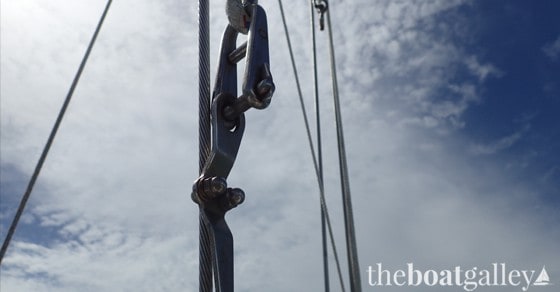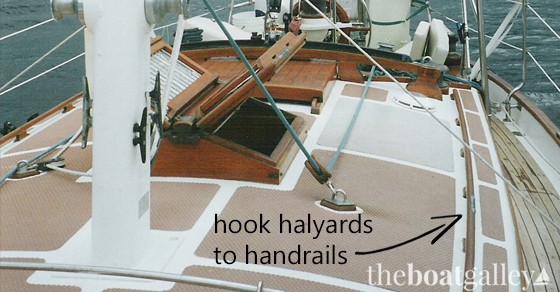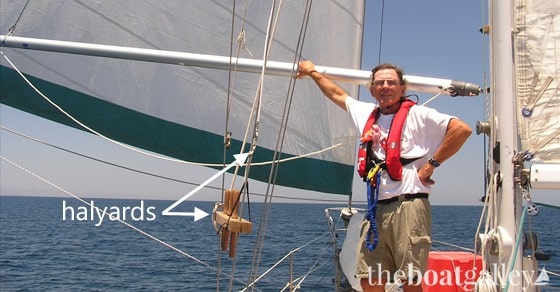Clank . . . clank . . . clank. The halyards were quiet earlier, but as the wind changed they being driving you nuts. It’s even worse if you are trying to sleep. Some sailors argue that the sound is romantic. Your neighbors may disagree. But also be aware that allowing your halyards to slap will decrease their lifespan, requiring more frequent replacement.
If you’re a new cruiser, it can be frustrating to figure out how to stop the clanking. First, there’s the obvious choice: tightening halyards to take up slack. Sadly, it doesn’t work. It just changes the pitch of the clank.
On our personal boats and several charter boats that we’ve been on, we’ve learned numerous ways that work. All involve getting the halyard far enough away from the mast that it can’t bang against it. Note that if you have external halyards, both ends may need to be led away from the mast.
Give these methods a try. One of them should work for you.
Bungee Halyards to Sidestays
Using bungee cords to pull halyards away from the mast is the fastest and easiest solution. But you’ll need to have a bunch of bungee cords.
Simply slack the halyard a bit, hook the bungee on it and then hook the bungee on the sidestay. If it’s too long to really pull the halyard off the mast, tie a knot in the bungee. You can also wrap the bungee around the sidestay and hook it back on the halyard. If you have two halyards to quiet, you can bungee them together.

Out in the sun, bungees will last anywhere from six months to a year. We used them for many things. If you buy a “jar” of varied sizes, you’ll always have what you need. You can find them in home improvement stores or Amazon. Check out this jar of 24 assorted bungee cords with hooks (Amazon). Related products will offer more options. Note that the mini bungee cords are great for many things on a boat. They are not, however, but strong enough to keep halyards from clanking.
Alternative: In a pinch, you can do the same thing with a piece of line. The downside is that it takes longer to set up and longer to un-rig when you want to sail. Smaller line works better than heavier line.
Tie off to a Shroud Cleat
If you looked closely at the picture above, you may have noticed another way to keep halyards off the mast: a shroud cleat. These are usually used for cleating off flag halyards. They often have an eye at the top that you can clip a halyard to. Tighten the halyard so that there is no slack to slap against the mast.

Amazon sells lightweight nylon and plastic shroud cleats with eyes. We, however, preferred the stainless shroud cleats from C. Sherman Johnson at West Marine. Interestingly, they’re about the same price as many of the lesser quality ones on Amazon.
They are slightly cheaper from Defender, but if you’re near a West Marine Store their free ship-to-store more than makes up for it.
Hook Halyards to Handrails
If your halyards are long enough and you have handrails in the right spot, wrap the halyard around the handrail and clip it back to itself. Then, just tighten the halyard to keep it off the mast.

Belaying Pin Rack
Sometimes, “classic” looking boats, such as our former Tayana 37, will have a rack of belaying pins on the shrouds. These are perfect for attaching the halyards to!
Depending on the halyard length, you can wrap them around the pins. Just wrap around the bar and clip back on the halyard. You can also make a loop from another line around the bar and clip the halyard to that. Again, tighten the halyard so there is no slack.

Be Kind to Your Neighbors
Even if you don’t spend nights on your boat, be kind to your neighbors and silence your halyards. If you’re not on your boat fulltime — or are leaving for a few days — you probably have one or two people that you’ve asked to “keep an eye” on your boat. Be sure that they know that it’s okay to come aboard to quiet a clanking halyard should the need arise!

Carolyn Shearlock has lived aboard full-time for 17 years, splitting her time between a Tayana 37 monohull and a Gemini 105 catamaran. She’s cruised over 14,000 miles, from Pacific Mexico and Central America to Florida and the Bahamas, gaining firsthand experience with the joys and challenges of life on the water.
Through The Boat Galley, Carolyn has helped thousands of people explore, prepare for, and enjoy life afloat. She shares her expertise as an instructor at Cruisers University, in leading boating publications, and through her bestselling book, The Boat Galley Cookbook. She is passionate about helping others embark on their liveaboard journey—making life on the water simpler, safer, and more enjoyable.


Pamela Dakin Harwood says
I don’t mind when they are slatting against a wood mast, but otherwise it keeps me awake.
Ray-Dianna Kowerchuk says
Yes it’s my wind chime
Carolyn Shearlock says
I’m really surprised at how many say they like it. Somehow, I don’t think they live full time on their boats . . .
Keith & Nicki, s/v Sionna says
In fairness to both, from a distance I find the sound pleasant, but on our boat or a closer neighboring boat, it’s maddening! I too have done the “naked madness at 3am” routine trying to silence the noise! And we have a ketch, so twice as many lines to deal with!
On Sionna we have short lengths of small line (3/16″) permanently served to the forward lower shrouds of both masts for the purpose. Free, simple to adjust, and last a couple of years, even with daily liveaboard use. Stow with a rolling hitch to the shroud when we’re sailing, always there when we need them.
Dan N Jaye says
Besides annoying the neighbours it puts lots of unnecessary wear on your halyards and you will have to replace them sooner.
David says
Exactly! Ever heard the term gill guys used to describe the devices to prevent banging? I can not find it written but old sailors told me about that term
el says
Can you bind them to the shrouds as well? Or maybe the owners?
Carolyn Shearlock says
That would make it a little tough when you want to go sailing — much longer to undo.
Carolyn Shearlock says
I have heard of people cutting up pool noodles and sliding section in the mast, and others who have used styrofoam peanuts. With either, you have to be very careful not to bind up the halyards — and it’s a bear of a job if you ever want to get them out. I’ve never personally done either.
Mara - S/V Dust in the Wind says
When mast is down and you are possibly re-wiring, tie wires together with a cable tie and leave the tail on on. Stagger their direction. In-mast halyards, etc. will still work through and slide on by, but the wiring will stay silent and you will be able to sleep! Did that on our Tartan 27-2…..what a difference!!! Just moved up to a Pearson 34-2 and can’t wait to take the mast down to do the same. May have to wait another year though. Everything works, and it’s not in the budget for just a noise issue! 🙁
Mara says
PS – Pool noodles/pipe covers, styrofoam peanuts, etc. will all eventually degrade…..making a huge mess!
Carolyn Shearlock says
The one problem with using wire ties (zip ties/cable ties) is that if you ever need to replace just ONE of the wires — and want to remove the bad wire — it’s impossible to do so.
Cap'n Dave says
This is the easiest method I’ve found, but it does lead to chafe. The new (or should I say “new” – it’s been a couple of years now) jib halyard I put up is already showing some fuzz where it hits the upper shrouds.
As for the wiring inside the mast? Yep, I hear it, but only if I go into the head at 3am (keel-stepped mast). I rarely hear it when I’m in the V-berth.
Now if I can just arrest the harmonic vibration of the shrouds themselves! Sometimes that really creates a staccato that you can’t really hear outside, but oh can you hear it down below!
Tami says
Slatting halyards: not only chafing the halyard itself, but is eating the anodizing, paint, or whatever finish on the mast. Not good.